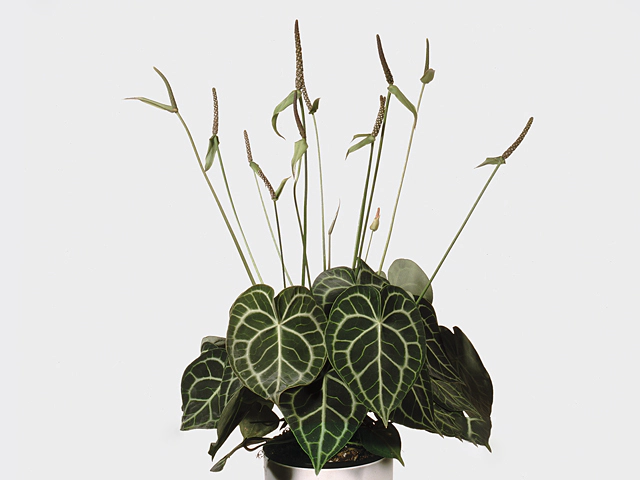Anthurium not flowering clarinervium

| Leaf tip | Mucronate |
| Flower color | Green-medium brown green-147B |
| Leaf, general shape | Cordate (heart-shaped) |
| Flower diameter | 1,5 - 2 cm |
| Plant height | 40 - 50 cm |
| Leaf width | 10 - 15 cm |
| Leaf size | 15 - 20 cm |
| Leaf, main color | Dark green |
| Plant structure/crown structure | Compact |
| Leaf colour, pattern | Bicolored; Veined |
| Leaf, secondary color(s) | Light green |
The Anthurium clarinervium, also known as the Flamingo Plant, is a popular houseplant known for its stunning foliage. With its distinct leaf shape and striking leaf patterns, it is no wonder that many plant enthusiasts are drawn to this beautiful species. However, one common issue that Anthurium clarinervium owners may face is the plant not flowering. Let's explore some possible reasons for this and ways to encourage blooming in your Flamingo Plant.
One aspect to consider is the leaf tip of the Anthurium clarinervium, which is mucronate. This means that the leaf ends in a small, sharp point. The vibrant green-medium brown-green 147B flower color of this plant provides a lovely contrast to its dark green, heart-shaped leaves. The flower diameter typically ranges from 1.5 to 2 cm, while the plant itself can reach a height of 40 to 50 cm.
The Anthurium clarinervium boasts leaves that are around 10 to 15 cm in width and 15 to 20 cm in size. The main color of the leaves is a deep, dark green, while the leaf pattern is bicolored and veined. Additionally, the secondary color of the leaves is a light green, which adds to the overall visual interest of this species. The plant's structure is known to be compact, making it a suitable choice for indoor spaces.
Now, let's address the main concern of Anthurium clarinervium owners – the lack of flowering. Despite its captivating foliage, the Flamingo Plant can be somewhat finicky when it comes to blooming. One possible reason for the absence of flowers is the plant's maturity. Anthurium clarinervium typically takes a few years to reach flowering age, so patience is crucial. If your plant is still young, give it time to establish itself and develop before expecting blooms.
Another factor that may inhibit flowering is improper care. Anthurium clarinervium thrives in bright indirect light. If the plant is not receiving enough light, it may focus its energy on leaf production rather than producing flowers. Ensure that you place your Flamingo Plant in a well-lit area, but avoid direct sunlight as it can scorch the leaves.
Proper watering is also important for encouraging flowering in Anthurium clarinervium. Overwatering can lead to root rot, which can hinder flower production. Allow the top inch of the soil to dry out between waterings and ensure proper drainage to prevent excess moisture.
Additionally, providing the right humidity levels can make a difference in blooming. Anthurium clarinervium thrives in higher humidity, similar to its natural rainforest habitat. Consider using a humidifier or placing a tray of water near the plant to increase the moisture in the air.
Feeding your Anthurium clarinervium with a balanced fertilizer specifically formulated for flowering plants can also promote blooming. Follow the instructions provided on the fertilizer packaging for the best results.
In conclusion, if your Anthurium clarinervium is not flowering, there are several factors to consider. Remember that this plant takes time to mature before producing blooms. Ensure that it receives adequate light, appropriate watering, and high humidity levels. By providing the right care and conditions, you can increase the chances of enjoying the beautiful flowers of the Flamingo Plant. Happy gardening!